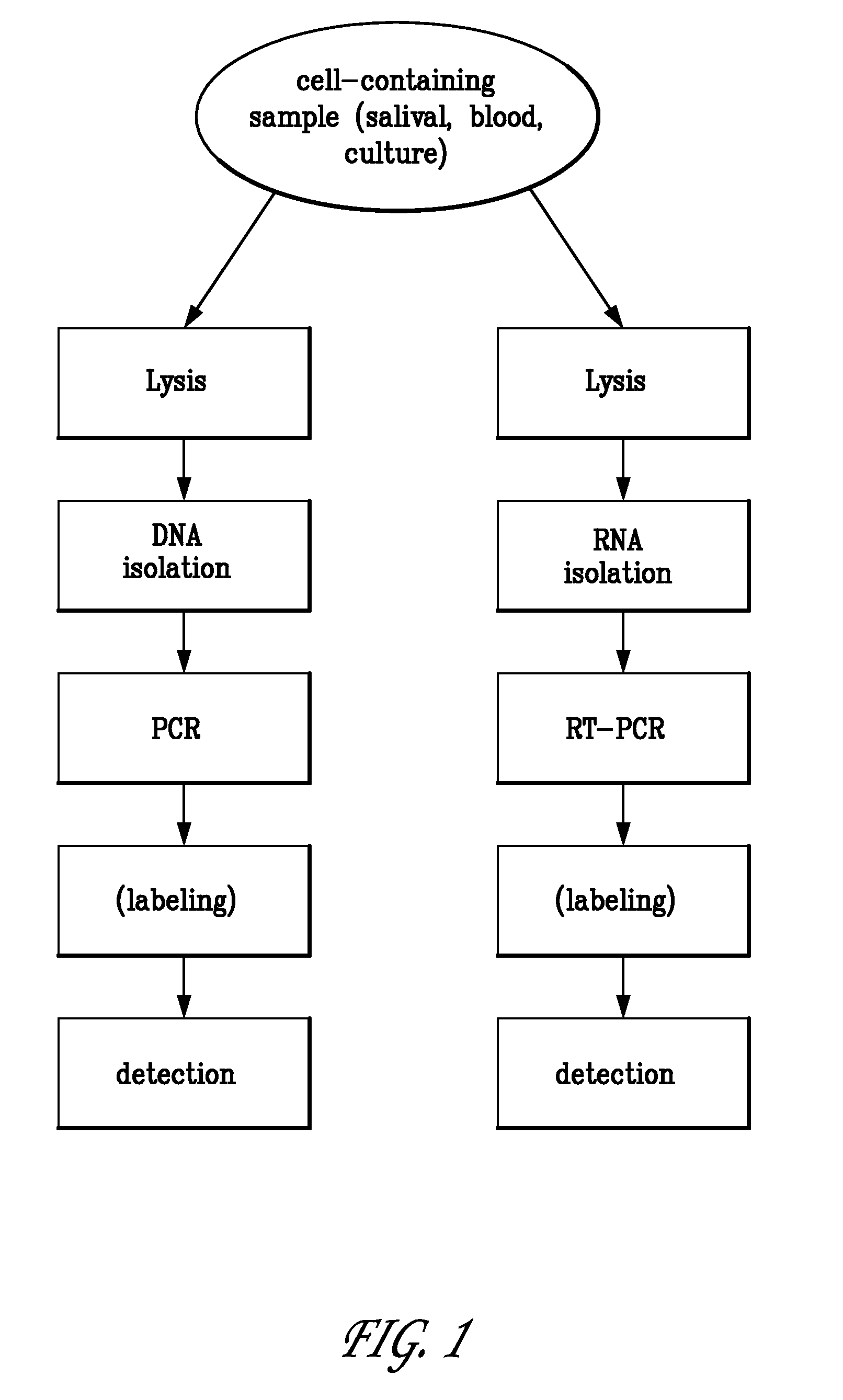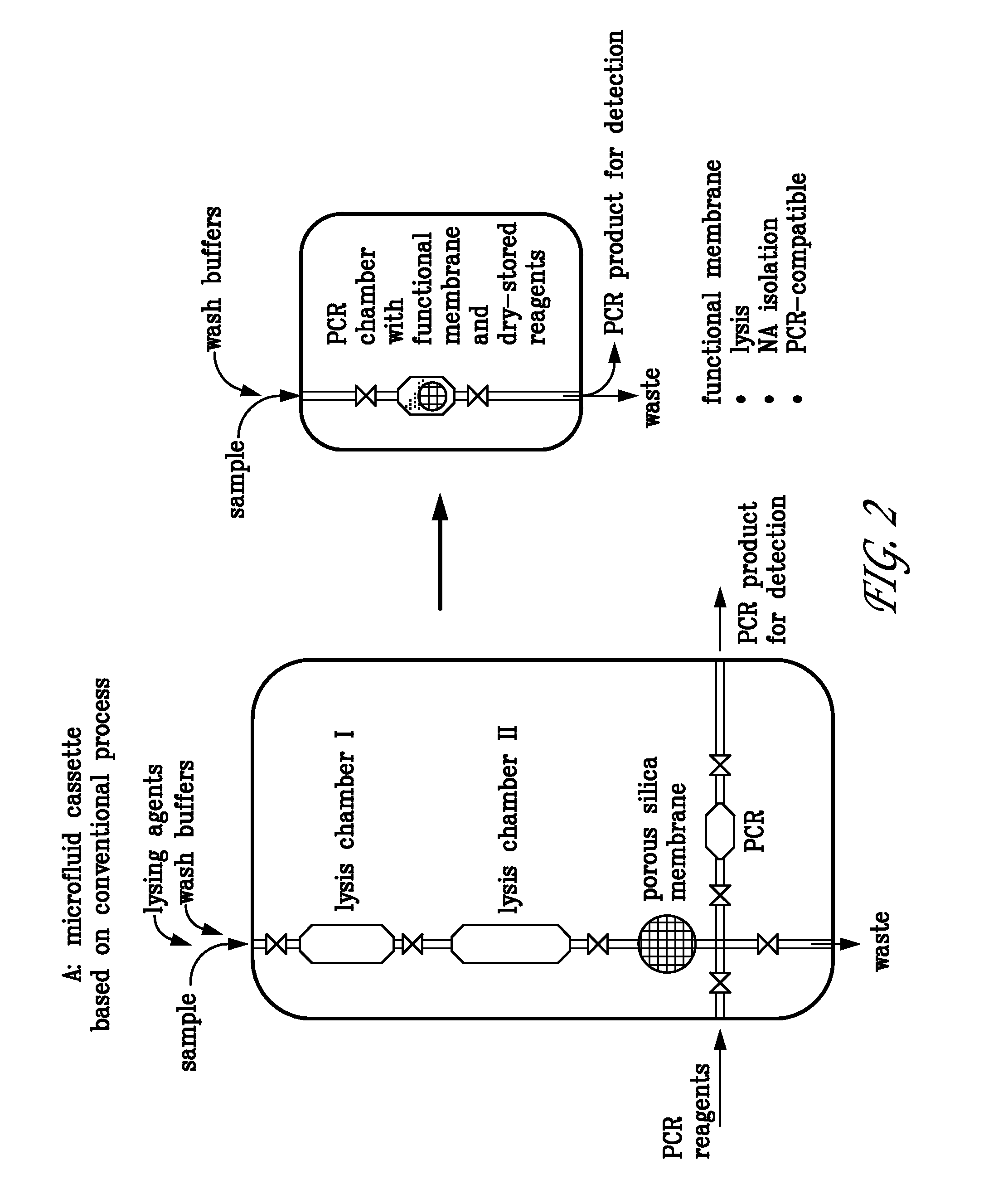Integrated PCR Reactor for Cell Lysis, Nucleic Acid Isolation and Purification, and Nucleic Acid Amplication Related Applications
a cell lysis and pcr technology, applied in the field of diagnostic devices, can solve the problems of labor intensive, time-consuming, resource-intensive, and labor-intensive pcr-based processes, and achieve the effects of reducing labor intensity, reducing labor intensity, and reducing labor intensity
- Summary
- Abstract
- Description
- Claims
- Application Information
AI Technical Summary
Benefits of technology
Problems solved by technology
Method used
Image
Examples
examples and further embodiments
Working Example Number 1
Streamlined Chip-Based Lysis, NA Isolation, and PCR
[0072]This example describes a plastic (polycarbonate) PCR chip that utilizes a single chamber for bacterial cell lysis, nucleic acid isolation, and PCR. FIG. 3 shows the steps in preparing the chip for operation. PCR reagents (including primers and Taq polymerase) are mixed with a commercial preservative (Biomatrica™, www.biomatrica.com (San Diego, Calif., USA), pre-loaded into the chamber of the chip (unbonded with no cover), and dried as a film coating the inside the chamber. The dried PCR charge is encapsulated with a layer of paraffin wax that protects the PCR mix from dissolution during the lysis and various wash steps. A 1.2-mm or 2.0-mm diameter Whatman FTA™ (www.whatman.com, Kent, UK) membrane disc is inserted into the chamber. Next, the chip cover (with inlet and outlet ports) is solvent-bonded using acetonitrile to form an enclosed chamber.
[0073]The chip is ready for sample testing. The operational...
working example 2
Use of an Whatman Alumina Anodisc Membrane as Nucleic Acid Binding Phase in Single-Chamber Lysis, Nucleic Acid Isolation
[0118]The prior art suggests that porous aluminum oxide (“alumina”) membranes are good candidates for nucleic acid binding media in solid-phase extraction. Whatman, Inc. (has commercialized a porous alumina oxide with 0.2 micron pores and 0.02 micron pores.
[0119]Fabrication
[0120]The chip fabrication is as described in Working Example 1 with exceptions noted as follows. An aluminum oxide disc is used in place of the Whatman FTA□ disc as the nucleic acid binding membrane. The thin (60 micron) alumina discs are more fragile than the Whatman FTA™ membranes. Whatman Anodisc™ membrane filters (Whatman Cat. No. 6809-6002, 0.2 micron pore size, 25 mm in diameter with a polyethylene supporting ring) can be cut into smaller discs (1 to 6 mm in diameter) using a CO2 laser (Model X-660 Universal Laser Systems, Scottsdale, Ariz.). For laser cutting, the Anodisc™ membrane is sup...
working example 3
Chip with Membrane Mounted for In-Line Flow-Through
[0124]In the previous designs shown in Working Examples 1 and 2, the free-standing membranes are inserted into the chamber. The membrane is immersed in liquid during sample loading, washes, and PCR. This arrangement is probably not optimal with respect to capturing and lysing cells and viruses, nucleic binding nucleic efficiency, and maximizing the effectiveness of wash steps. In another embodiment of the invention, as shown in FIG. 16, the chamber is partitioned with a horizontally mounted membrane. In this design, all of the sample and wash solutions are forced to flow though the porous membrane. This design should increase the binding efficiency of the membrane and the efficacy of washing steps.
[0125]This design has been implemented by CNC (computer numerical control) machining as shown in FIGS. 17a and 17b. The top and middle part of the chip are machined from polycarbonate plates. The alumina membrane is inserted in a recess an...
PUM
| Property | Measurement | Unit |
|---|---|---|
| Length | aaaaa | aaaaa |
| Length | aaaaa | aaaaa |
| Length | aaaaa | aaaaa |
Abstract
Description
Claims
Application Information
 Login to View More
Login to View More - R&D
- Intellectual Property
- Life Sciences
- Materials
- Tech Scout
- Unparalleled Data Quality
- Higher Quality Content
- 60% Fewer Hallucinations
Browse by: Latest US Patents, China's latest patents, Technical Efficacy Thesaurus, Application Domain, Technology Topic, Popular Technical Reports.
© 2025 PatSnap. All rights reserved.Legal|Privacy policy|Modern Slavery Act Transparency Statement|Sitemap|About US| Contact US: help@patsnap.com



